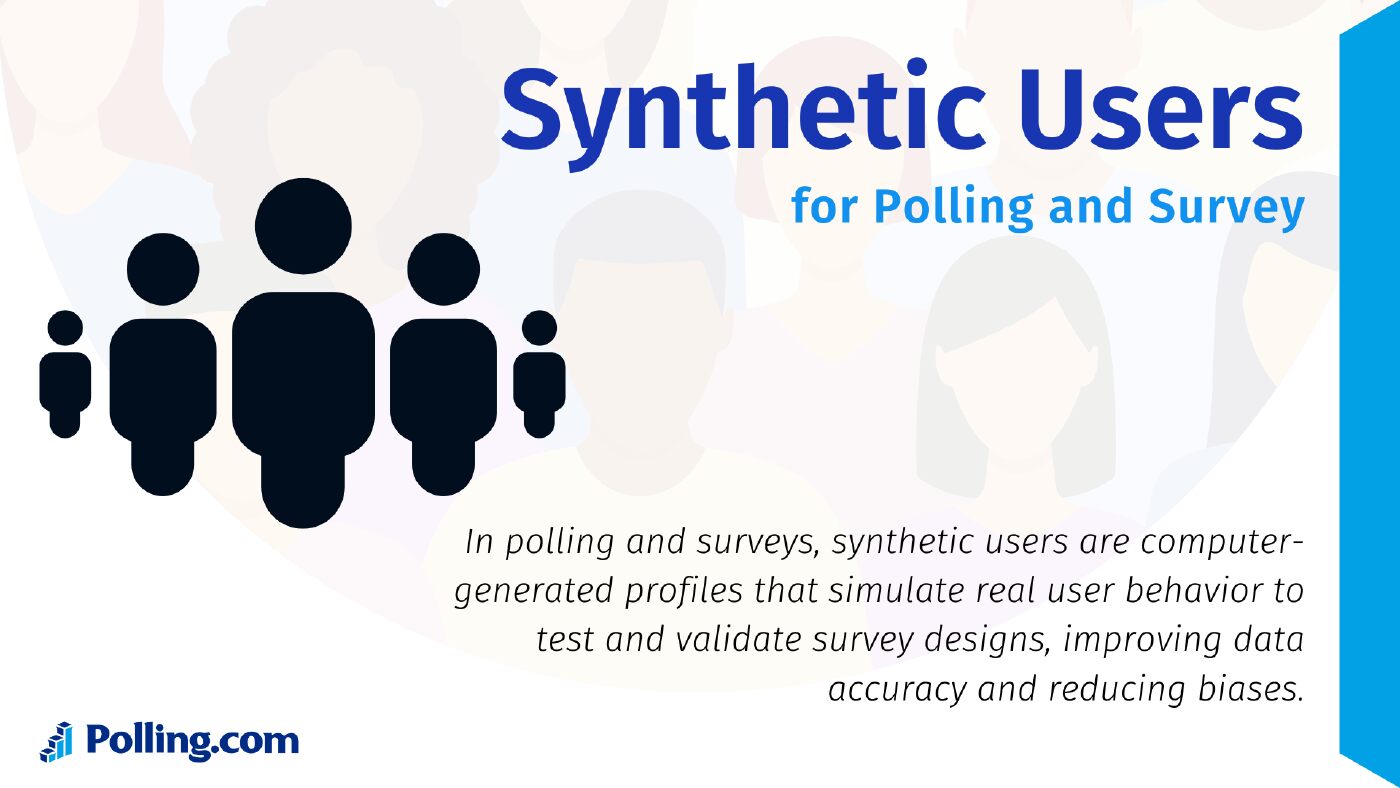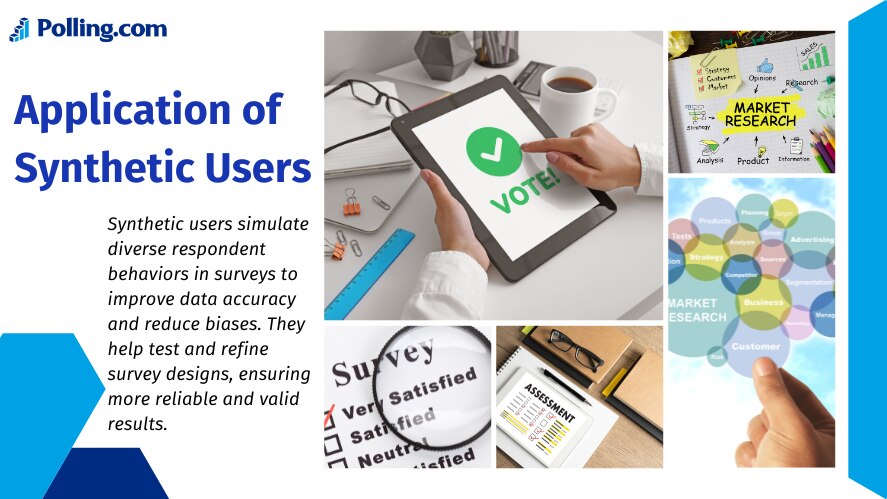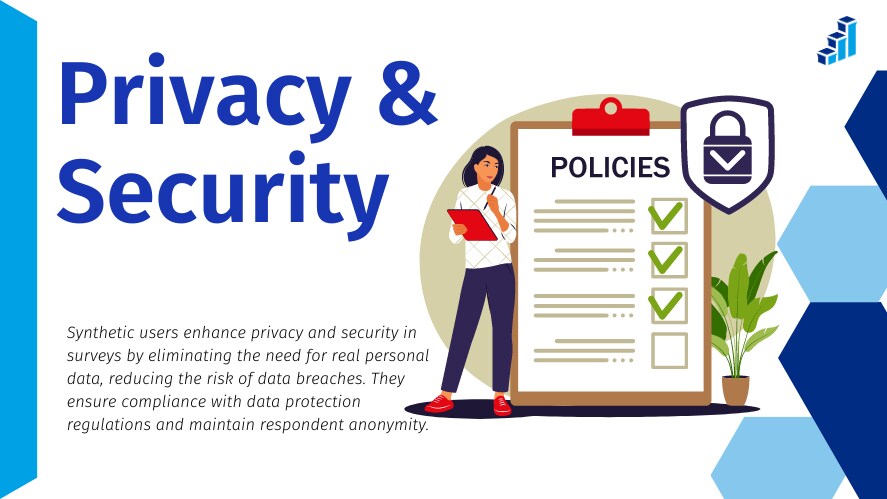
Role of Synthetic Users in Polling and Survey Services
Have you ever wondered how surveys and polls could become more reliable in an era of declining response rates and increasing biases? Enter synthetic users.
These AI-driven entities are revolutionizing data collection, promising greater accuracy and efficiency. But what exactly are synthetic users, and how are they shaping the future of survey services?
Overview of Synthetic Users in Surveys
The concept of synthetic users is not new, but its application in surveys and polling has garnered significant attention in recent years.
Synthetic users are virtual entities generated through advanced algorithms and AI techniques to simulate human behavior and responses. These users are designed to replicate the diversity and complexity of real human respondents without the associated biases and limitations.
Definition and Importance of Synthetic Users
Synthetic users are computer-generated profiles that mimic real human respondents in surveys and polls. They are essential for addressing issues such as low response rates, high costs, and respondent biases.
By using synthetic users, researchers can gather large amounts of data quickly and cost-effectively while maintaining the integrity and reliability of the results.
Brief History and Evolution in the Context of Surveys
The evolution of synthetic users in surveys dates back to the early days of computer simulations and AI.
Initially, these virtual entities were used in limited contexts, primarily for testing and development. However, advancements in machine learning and data integration have expanded their use, making them a valuable tool for modern survey services.
Purpose of Using Synthetic Users in Modern Polling
The primary purpose of synthetic users in modern polling is to enhance data collection and analysis. They help overcome common challenges such as non-response bias, high operational costs, and the logistical difficulties of reaching diverse populations.
Synthetic users provide a scalable solution that can be tailored to specific research needs, ensuring more accurate and representative results.
What are Synthetic Users?
Definition and Characteristics

Synthetic users are digital constructs created through sophisticated algorithms and AI techniques. They are designed to emulate the behavior, preferences, and responses of real human respondents. Key characteristics of synthetic users include:
- Diversity: Synthetic users can represent a wide range of demographics, behaviors, and preferences.
- Scalability: They can be generated in large numbers to meet the needs of extensive surveys.
- Adaptability: Synthetic users can be tailored to specific research objectives and adjusted based on real-time data.
- Consistency: Unlike human respondents, synthetic users provide consistent and reliable data without fatigue or bias.
Creation of Synthetic Users
The creation of synthetic users involves several advanced technologies and methodologies. Key steps include:
- Data Collection and Integration: Gathering data from various sources to create comprehensive user profiles.
- Algorithm Development: Designing algorithms that can generate realistic and diverse synthetic users.
- Machine Learning: Using machine learning techniques to refine and improve the accuracy of synthetic user behaviors and responses.
Why Use Synthetic Users in Surveys?
Advantages
Using synthetic users in surveys offers numerous benefits, including:
- Cost Efficiency and Scalability: Synthetic users eliminate the need for extensive human recruitment and compensation, significantly reducing costs.
- Reducing Response Biases: By simulating a wide range of behaviors and preferences, synthetic users help minimize biases that can skew survey results.
- Speed and Efficiency: Synthetic users can quickly generate large datasets, accelerating the research process and enabling real-time analysis.
Challenges and Limitations
Despite their advantages, synthetic users also present certain challenges and limitations:
- Ethical Concerns: The use of synthetic users raises questions about transparency, consent, and the potential for misuse.
- Replicating Human Behavior: While synthetic users can simulate many aspects of human behavior, they may struggle to replicate the full complexity and unpredictability of real respondents.
Applications of Synthetic Users in Surveys

Market Research
In market research, synthetic users are invaluable for analyzing trends and consumer behaviors. They help researchers understand preferences, predict market shifts, and test new products or marketing strategies without the biases and limitations of traditional survey methods.
Political Polling
Political polling benefits from the accuracy and reliability of synthetic users. By simulating diverse voter demographics and behaviors, synthetic users enhance the precision of election forecasts and policy impact assessments.
Consumer Behavior Analysis
Synthetic users provide detailed insights into consumer preferences and purchasing patterns. They enable businesses to tailor their products and marketing strategies to meet the needs of their target audience effectively.
Ethical Considerations

Transparency and Disclosure
Transparency is crucial when using synthetic users in surveys. Researchers must disclose their use to stakeholders, ensuring that the integrity and credibility of the data are maintained.
Data Privacy and Security
Protecting the privacy and security of data used to create synthetic users is paramount. Robust measures must be in place to prevent data breaches and misuse.
Impact on Public Trust
The use of synthetic users can impact public trust in survey results. It is essential to maintain transparency and ethical standards to ensure that the public remains confident in the validity of the data.
Case Studies and Real-World Examples
Several organizations have successfully implemented synthetic users in their survey processes. For instance, market research firms have used synthetic users to predict consumer trends with high accuracy, while political analysts have improved the reliability of their election forecasts.
These implementations offer valuable insights, highlighting the importance of algorithm refinement, ethical considerations, and ongoing validation to ensure the effectiveness of synthetic users.
Future of Synthetic Users in Surveys
Future advancements in AI and machine learning will continue to enhance the capabilities of synthetic users. Improved algorithms and data integration techniques will enable even more accurate and diverse simulations.
As synthetic users become more sophisticated, their use in surveys and polling will likely expand. Researchers will increasingly rely on synthetic users for real-time data analysis, predictive modeling, and more comprehensive insights.
Synthetic users present numerous opportunities for innovation in survey services. They can help address emerging challenges, such as declining response rates and increasing data privacy concerns, while providing new solutions for data collection and analysis.
Conclusion
Synthetic users represent a significant advancement in the field of survey services. They offer numerous benefits, including cost efficiency, reduced biases, and enhanced scalability. However, ethical considerations and the challenges of replicating human behavior must be carefully managed.
As technology continues to evolve, synthetic users will play an increasingly important role in shaping the future of surveys and polling. Researchers and organizations must embrace these innovations while maintaining ethical standards to ensure the reliability and credibility of their data.
Further research is needed to refine synthetic user technologies and address ethical concerns. Stakeholders must work together to establish guidelines and best practices that ensure the responsible use of synthetic users in surveys and polling services.
